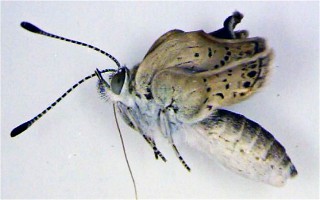Fukushima butterflies: nuclear disaster after-effects
Community and Forum → Blog → Fukushima butterflies: nuclear disaster after-effects
Lev Bely, 17.08.2012 22:33

The Fukushima 2011 nuclear disaster caused abnormalities in butterfly species on site, reporting a group of Japanese researches.
“We conclude that artificial radionuclides from the Fukushima (No. 1) nuclear power plant caused physiological and genetic damage” in common Japanese butterfly species The Pale Grass Blue (Pseudozizeeria maha), according to an article published in Scientific Reports journal. Also said that radiation affected badly the species genes and mutations will be transferred to next generations.
“Sensitivity (to irradiation) varies between species, so research should be conducted on other animals,” said Joji Otaki, one of the researches and associate professor at the University of the Ryukyus in Okinawa.
“Humans are totally different from butterflies and they should be far more resistant to the health effects of radiation,” Otaki noted.
In May last year, two months after the Fukushima disaster occurred, researches gathered 121 P. maha imagos within the affected area and not far outside. 12 percent of the collected butterflies had unusually small underdeveloped wings. The offspring of the gathered butterflies had 18 percent of small wing butterflies, whilst some of them died before reaching the adult stage.
Among the butterflies of a second generation which mated with healthy butterflies of the same species, abnormal specimens increased to 34 percent.
In September last year researches gathered and studied 238 butterflies of this species, and concluded that the abnormality rate stuck at 28 percent. However, in the next generation got from the gathered butterflies, it raised to nearly 52 percent.
The researchers said that the butterflies collected in May were heavily exposed to radiation as larvae. The impact was apparently more severe in the second generation, as well as with the butterflies collected in September, because they suffered heavy exposure at a far earlier stage of a fertilized egg or reproduction cell, according to the team.
They also made a series of tests with P. maha larvae collected in Okinawa, one of the Japanese prefectures less affected by a nuclear disaster. Caterpillars that were artificially irradiated and fed on the foliage treated with radioactive materials, showed as adults the same abnormalities and at same percentage, as well as premature death, that the gosammer-winged butterflies gathered in the affected area.
The Japan Times, http://www.japantimes.co.jp
Photo: P. maha imago with underdeveloped wings, Inhabitat.com, http://inhabitat.com
All the rest posts on: Asia, science, danger zone, ecology, Japan
Comments
New comment
Note: you should have a Insecta.pro account to upload new topics and comments. Please, create an account or log in to add comments.
* Our website is multilingual. Some comments have been translated from other languages.
Random species of the website catalog
News
- 02.03.2025: Moscow Insect Fair: New section on the Insecta.pro Website
- 31.12.2024: If you need to upload a lot of photos to Insecta.pro website
- 10.12.2024: Новое поле в «Поиске энтомологов»
New photos (25.03.2025)
Fresh from the community
- 12:52, L. Bolshakov: Петр, см. там подробности: https://...
- 12:32, P. Khramov: Лавр, источник скиньте, пожалуйста....
- 23:33, L. Bolshakov: К сожалению, вы поступили неверно. ...
Popular insects
Recommended blog topics
- ICZN Election of Commissioners
- The insects exhibition in Kotlas
- Meantime in Japan
- Caterpillar hair can cause abortions in Australian mares



























